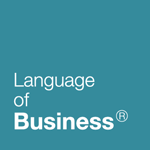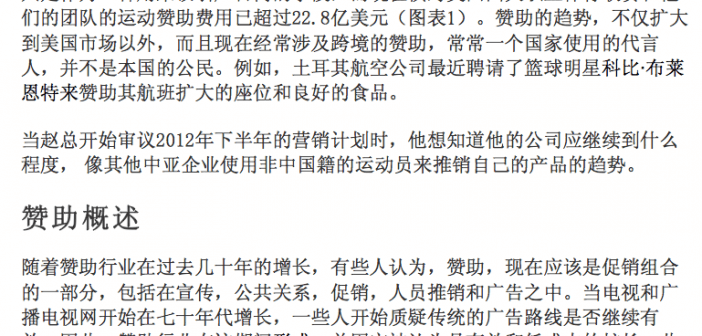One of my more memorable consulting engagements has been working with a Boston-based sports organization to help design and implement business strategies related to expanding their business development efforts in Asia. To better assist them in finding clients, I’ve written a new case study on Cross Border Sponsorship, as defined as companies who use “foreign” athletes to help pitch their products (i.e., a mainland Chinese company using a non-Chinese athlete as a spokesperson). An expanded version of this case will be used in my summer Global Management class, in an effort to keep the classroom content as new as possible. The first few paragraphs of the case are below, followed by the Chinese version, and many thanks to Nancy Tow for her translation work.
Cross Border Sponsorship: The Newest Trend in Athlete Endorsements Outside of the United States
Sports sponsorship gained prominence in the 1970’s in the United States (US). According to Benoît Séguin, at the University of Ottawa, Canada, as television and radio licenses increased in the 1970’s, “competition between advertisers to attract consumers’ attention was fierce.” As originally coined by Tony Meenaghan in the International Journal of Advertising in 1991, sponsorship is defined as “an investment in cash or kind, in an activity, person or event (sponsoree, or athlete being sponsored), in return for access to the exploitable commercial potential associated with that activity, person or event by the investor (sponsor).” What originally began as a means to attract advertisers, according to IEG, across the four major U.S. pro sports leagues and their teams, is now over $2.28 bn. (Exhibit 1). The trend of sponsorship has not only expanded outside of US markets, but now is regularly involving cross-border sponsorship, where a country uses a spokesperson who’s not one of their citizens. For example, Turkish Airlines recently used basketball star Kobe Bryant to endorse its expanded seating capacity and good food.
As Mr. Zhao began reviewing his marketing plan for the 2nd half of 2012, he wondered to what extent his company should continue the trend of other Chinese, and Asian, firms in using non-Chinese athletes to pitch their products.
Sponsorship Overview
With the growth of sponsorships over the last few decades, some argue that sponsorships should now be considered part of promotional mix, along with publicity, public relations, sales promotions, personal selling, and advertising. When the number of television and radio networks began to grow in the 1970’s, some began to question the continued effectiveness of traditional advertising routes. As a result, sponsorships emerged and began to grow during this time period as they were considered effective at a lower cost. Additionally, sponsorships were considered different from traditional advertising as audiences with an “association” element thought of their perception separately.
跨境赞助:美国以外的运动员代言的最新趋势体育赞助在美国七十年代有显著的进展。据Benoît Séguin(伯努·瓦塞甘)在加 拿大渥太华大学报道“七十年代随着电视和电台执照的增加,为了吸引消费者的 注意,广告商的竞争变得异常激烈。”在1991年, Tony Meenaghan在国际广告杂 志上将“赞助”定义为“投资者(赞助商)以现金或实物投资在活动、人或事件 中(受赞助者或受赞助运动员),进而获得商业效益。”根据IEG的资讯,最初这 只是作为一种用来吸引广告商的手段,而现在横跨美国四大职业体育联赛和他 们的团队的运动赞助费用已超过22.8亿美元(图表1)。赞助的趋势,不仅扩大 到美国市场以外,而且现在经常涉及跨境的赞助,常常一个国家使用的代言 人,并不是本国的公民。例如,土耳其航空公司最近聘请了篮球明星科比·布莱 恩特来赞助其航班扩大的座位和良好的食品。
当赵总开始审议2012年下半年的营销计划时,他想知道他的公司应继续到什么 程度, 像其他中亚企业使用非中国籍的运动员来推销自己的产品的趋势。赞助概述
随着赞助行业在过去几十年的增长,有些人认为,赞助,现在应该是促销组合 的一部分,包括在宣传,公共关系,促销,人员推销和广告之中。当电视和广 播电视网开始在七十年代增长,一些人开始质疑传统的广告路线是否继续有 效。因此,赞助行业在这期间形成,并因它被认为是有效和低成本的扩长。此 外,赞助因为观众对其有“联系”的因素观念而被认为于传统的广告有所不同。企业和组织开始设定客观的赞助经营目标来保证投资回报率(ROI)。三个 类型的赞助目标被确定。首先是广义企业目标。二是营销目标,包括品牌推 广和促销。最后是媒体目标,包括影响到的目标市场范围,和取得成本效 益。总体而言,有些人认为,企业利用赞助来增加额外销售,提高盈利的目 标,而另一些人认为,企业试图利用赞助来实现多个目标。




